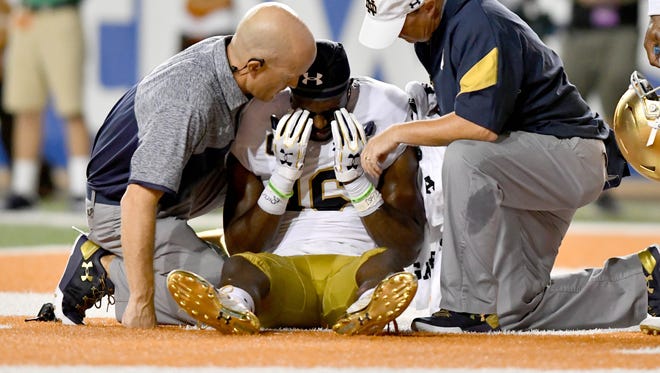College football’s rules committee to consider middle ground on targeting calls

The sometimes controversial targeting rule in college football could get a welcome tweak for next season. When the NCAA Football Rules Committee meets next month, it will consider adding a “middle ground,” according to secretary-rules editor Rogers Redding, that would in some cases allow the offending player to remain in the game even if the penalty is not overturned.
Currently, a targeting call — defined by rule as “making forcible contact with the crown of the helmet,” or “making forcible contact to the head or neck area of a defenseless player” — results in a 15-yard penalty and the ejection of the player who committed the foul. If the foul occurs in the second half of a game, the player is also suspended for the first half of the next game.
Each call undergoes review; the replay official can confirm or reverse the call. Under the proposed change, a player would be given a reprieve if the replay official does not reverse the call but does not have enough evidence to confirm it. The 15-yard penalty would be enforced, but the player would not be ejected.
“If the replay official has more time and more angles and says, ‘I can’t really confirm it’s targeting,’ the default position is the call on the field is correct, so it stands,” Redding said of the proposal. “But we’re not gonna throw him out. … The idea is that certainly the officials on the field saw something. We can’t say, ‘No, it’s not targeting,’ but there’s more middle ground.”
Redding, whose term as secretary-rules editor expires in August (he’s also the national officiating coordinator), said even with the reprieve, the penalty would remain a deterrent to dangerous hits.
“It’s not backing away from anything,” Redding said. “The kid is put on notice. He knows he did something to draw that flag. He was close to getting himself tossed out of the ballgame. That may give him pause about how he approaches making that same type of play.”
Because this is considered an off year in the rules cycle, only rules related to player safety can be considered. If the rules committee decided to change the targeting rule, it would forward a proposal to the Playing Rules Oversight Panel, which would make the final decision later this spring.
The targeting rule was first enacted in 2013 in hopes of reducing dangerous play, and has been tweaked several times. By rule, targeting requires forcible contact and other indicators: Did the penalized player launch into the collision? Did he lead with his helmet, shoulder, forearm, etc.? Was the other player defenseless?
A year ago the rules committee expanded the ability of replay officials to review targeting, giving them the ability to attempt to determine whether there was intent. In addition to reversing calls, the new rule allowed replay officials to call targeting missed by officials on the field in what Redding termed “egregious” instances.
MORE COLLEGE FOOTBALL NEWS
Which new college football coach steps into best situation?
Which new college football coaches step into toughest situations?
The number of targeting calls has risen in each season since the rule was implemented in 2013. In 2016, targeting was called 196 times and reversed 51 times — meaning 144 ejections when the penalty was upheld 144. All three numbers were the most ever; the 144 upheld calls doubled the 72 in 2014, two years earlier.
Todd Berry, the executive director of the American Football Coaches Association, said while coaches supported the concept of targeting, they’d like to continue to evaluate its definition and how it is called. In particular, Berry pointed to instances when a receiver is descending after making a catch and a defensive player is unable to adjust to avoid making forcible contact in a way that, by the rule’s current definition, is illegal.
“It’s almost impossible whenever there’s that much degree of change for them to be athletically capable of (avoiding it),” Berry said. “If the player launches, certainly that’s malicious and there’s no place in football for that. But for a young man to be ejected because his shoulder hit a facemask when the (receiver’s) plan was changing – I don’t think there’s any great answers, but we need to have great conversations.”
Berry’s example isn’t likely to be addressed in a formal rule proposal this cycle. But Berry is in favor of the potential proposal to add Redding’s “middle ground” of the reprieve from ejection when there’s not enough evidence to confirm targeting in a replay review.
“We’ve changed behavior,” Berry said. “That’s what we were trying to address from the beginning. To change behavior, there needed to be a stiff penalty, which obviously ejection is. … But there’s nothing wrong with trying to make something continually better. This is something that impacts the student-athlete and we need to be very serious about having these conversations.”
COLLEGE FOOTBALL PRESEASON TOP 25 FOR 2017
